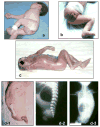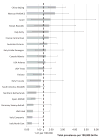Amelia: a multi-center descriptive epidemiologic study in a large dataset from the International Clearinghouse for Birth Defects Surveillance and Research, and overview of the literature
- PMID: 22002956
- PMCID: PMC4453759
- DOI: 10.1002/ajmg.c.30319
Amelia: a multi-center descriptive epidemiologic study in a large dataset from the International Clearinghouse for Birth Defects Surveillance and Research, and overview of the literature
Abstract
This study describes the epidemiology of congenital amelia (absence of limb/s), using the largest series of cases known to date. Data were gathered by 20 surveillance programs on congenital anomalies, all International Clearinghouse for Birth Defects Surveillance and Research members, from all continents but Africa, from 1968 to 2006, depending on the program. Reported clinical information on cases was thoroughly reviewed to identify those strictly meeting the definition of amelia. Those with amniotic bands or limb-body wall complex were excluded. The primary epidemiological analyses focused on isolated cases and those with multiple congenital anomalies (MCA). A total of 326 amelia cases were ascertained among 23,110,591 live births, stillbirths and (for some programs) elective terminations of pregnancy for fetal anomalies. The overall total prevalence was 1.41 per 100,000 (95% confidence interval: 1.26-1.57). Only China Beijing and Mexico RYVEMCE had total prevalences, which were significantly higher than this overall total prevalence. Some under-registration could influence the total prevalence in some programs. Liveborn cases represented 54.6% of total. Among monomelic cases (representing 65.2% of nonsyndromic amelia cases), both sides were equally involved, and the upper limbs (53.9%) were slightly more frequently affected. One of the most interesting findings was a higher prevalence of amelia among offspring of mothers younger than 20 years. Sixty-nine percent of the cases had MCA or syndromes. The most frequent defects associated with amelia were other types of musculoskeletal defects, intestinal, some renal and genital defects, oral clefts, defects of cardiac septa, and anencephaly.
Copyright © 2011 Wiley Periodicals, Inc.
Figures



Similar articles
-
Phocomelia: a worldwide descriptive epidemiologic study in a large series of cases from the International Clearinghouse for Birth Defects Surveillance and Research, and overview of the literature.Am J Med Genet C Semin Med Genet. 2011 Nov 15;157C(4):305-20. doi: 10.1002/ajmg.c.30320. Epub 2011 Oct 14. Am J Med Genet C Semin Med Genet. 2011. PMID: 22002800 Free PMC article. Review.
-
Sirenomelia: an epidemiologic study in a large dataset from the International Clearinghouse of Birth Defects Surveillance and Research, and literature review.Am J Med Genet C Semin Med Genet. 2011 Nov 15;157C(4):358-73. doi: 10.1002/ajmg.c.30324. Epub 2011 Oct 14. Am J Med Genet C Semin Med Genet. 2011. PMID: 22002878 Free PMC article. Review.
-
Cloacal exstrophy: an epidemiologic study from the International Clearinghouse for Birth Defects Surveillance and Research.Am J Med Genet C Semin Med Genet. 2011 Nov 15;157C(4):333-43. doi: 10.1002/ajmg.c.30317. Epub 2011 Oct 14. Am J Med Genet C Semin Med Genet. 2011. PMID: 22002951 Review.
-
Acardia: epidemiologic findings and literature review from the International Clearinghouse for Birth Defects Surveillance and Research.Am J Med Genet C Semin Med Genet. 2011 Nov 15;157C(4):262-73. doi: 10.1002/ajmg.c.30318. Epub 2011 Oct 14. Am J Med Genet C Semin Med Genet. 2011. PMID: 22002952 Review.
-
Bladder exstrophy: an epidemiologic study from the International Clearinghouse for Birth Defects Surveillance and Research, and an overview of the literature.Am J Med Genet C Semin Med Genet. 2011 Nov 15;157C(4):321-32. doi: 10.1002/ajmg.c.30316. Epub 2011 Oct 14. Am J Med Genet C Semin Med Genet. 2011. PMID: 22002949 Free PMC article. Review.
Cited by
-
Association of upper limb meromelia, proximal focal femoral deficiency, fibular hemimelia, and intermetatarsal coalition in a young adult male.Radiol Case Rep. 2020 May 1;15(7):882-886. doi: 10.1016/j.radcr.2020.04.030. eCollection 2020 Jul. Radiol Case Rep. 2020. PMID: 32382373 Free PMC article.
-
Maternal Risk Factors Associated with Limb Reduction Defects: Data from the Polish Registry of Congenital Malformations (PRCM).Children (Basel). 2021 Feb 12;8(2):138. doi: 10.3390/children8020138. Children (Basel). 2021. PMID: 33673226 Free PMC article.
-
[Reporting of birth defects from the Zika outbreak in Colombia, 2015-2017Notificação de defeitos congênitos associados ao surto de vírus zika na Colômbia, 2015-2017].Rev Panam Salud Publica. 2019 May 3;43:e38. doi: 10.26633/RPSP.2019.38. eCollection 2019. Rev Panam Salud Publica. 2019. PMID: 31093262 Free PMC article. Spanish.
-
Geotemporospatial and causal inference epidemiological analysis of US survey and overview of cannabis, cannabidiol and cannabinoid genotoxicity in relation to congenital anomalies 2001-2015.BMC Pediatr. 2022 Jan 19;22(1):47. doi: 10.1186/s12887-021-02996-3. BMC Pediatr. 2022. PMID: 35042455 Free PMC article.
-
Amelia and phocomelia in Finland: Characteristics and prevalences in a nationwide population-based study.Birth Defects Res. 2022 Dec 1;114(20):1427-1433. doi: 10.1002/bdr2.2123. Epub 2022 Nov 9. Birth Defects Res. 2022. PMID: 36353751 Free PMC article.
References
-
- Agarwal P, Wylie JN, Galceran J, Arkhitko O, Li C, Deng C, Grosschedl R, Bruneau BG. Tbx5 is essential for forelimb bud initiation following patterning of the limb field in the mouse embryo. Development. 2003;130:623–633. - PubMed
-
- Bermejo-Sánchez E, Cuevas L, Amar E, Bianca S, Bianchi F, Botto LD, Canfield MA, Castilla EE, Clementi M, Cocchi G, Landau D, Leoncini E, Li Z, Lowry RB, Mastroiacovo P, Mutchinick OM, Rissmann A, Ritvanen A, Scarano G, Siffel C, Szabova E, Martínez-Frías ML. Phocomelia: A worldwide descriptive epidemiologic study in a large series of cases from the International Clearinghouse for Birth Defects Surveillance and Research, and overview of the literature. Am J Med Genet C Semin Med Genet. 2001 (in press) - PMC - PubMed
Publication types
MeSH terms
Grants and funding
LinkOut - more resources
Full Text Sources
Medical
Molecular Biology Databases

